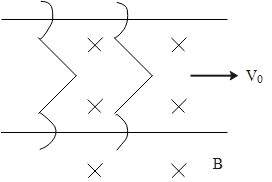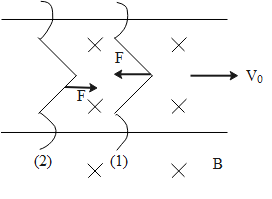
In the figure, there are two sliders and they can slide on two frictionless parallel wires in uniform magnetic field B, which is present everywhere. The mass of each slider is m, resistance R and initially, these are at rest. Now, if one slider is given a velocity ${{v}_{0}}=16m{{s}^{-1}}$ , what will be the velocity (in\[m{{s}^{-1}}\]) of other sliders after a long time? (Neglect the self-induction)


Answer
558.6k+ views
Hint: When a conductor experiences any change in the externally applied field a small force (emf) is developed in the conductor. This force will try to increase or decrease the speed of the moving conductor according to the direction of the induced force. When more than one conductor is continuously moving the mutual momentum of the conductor always remains the same (constant).
Complete step by step solution:
Initially $v=0$
The initial velocity of one slider ${{v}_{0}}=16m/s$
Consider the following circuit mentioned in the question at $t=0$ due to motion of wire a current is induced in the loop due to which current a magnetic force will generate act on the wire as shown in the following diagram,

Due to this current and force on the wire speed of wire-2 increases and wire-1 decreases. After a long time when both the wires have no relative velocity between them, the flux charge between them becomes zero, and the induced current becomes zero.
So, according to the law of conservation of linear momentum, the net initial momentum should be equal to the net final momentum of the body (conductor). By applying the law of conservation of linear momentum in the situation given in the question,
${{p}_{i}}={{p}_{f}}$
$\begin{align}
& m{{v}_{0}}=mv+mv \\
& v=\dfrac{{{v}_{0}}}{2} \\
\end{align}$
Thus the velocity of wire (2) will be,
$\begin{align}
& v=\dfrac{16}{2} \\
& \Rightarrow v=8m/s \\
\end{align}$
Thus, $8m/s$ is the required answer to the question.
Note: When a current-carrying conductor experiences a changing flux an emf is induced in the circuit. This is known as induction. Broadly there are two kinds of induction one is self-induction and another is mutual induction. In self-inductance, only one conductor is involved in mutual inductance two conductors come into play.
Complete step by step solution:
Initially $v=0$
The initial velocity of one slider ${{v}_{0}}=16m/s$
Consider the following circuit mentioned in the question at $t=0$ due to motion of wire a current is induced in the loop due to which current a magnetic force will generate act on the wire as shown in the following diagram,

Due to this current and force on the wire speed of wire-2 increases and wire-1 decreases. After a long time when both the wires have no relative velocity between them, the flux charge between them becomes zero, and the induced current becomes zero.
So, according to the law of conservation of linear momentum, the net initial momentum should be equal to the net final momentum of the body (conductor). By applying the law of conservation of linear momentum in the situation given in the question,
${{p}_{i}}={{p}_{f}}$
$\begin{align}
& m{{v}_{0}}=mv+mv \\
& v=\dfrac{{{v}_{0}}}{2} \\
\end{align}$
Thus the velocity of wire (2) will be,
$\begin{align}
& v=\dfrac{16}{2} \\
& \Rightarrow v=8m/s \\
\end{align}$
Thus, $8m/s$ is the required answer to the question.
Note: When a current-carrying conductor experiences a changing flux an emf is induced in the circuit. This is known as induction. Broadly there are two kinds of induction one is self-induction and another is mutual induction. In self-inductance, only one conductor is involved in mutual inductance two conductors come into play.
Recently Updated Pages
A man running at a speed 5 ms is viewed in the side class 12 physics CBSE

The number of solutions in x in 02pi for which sqrt class 12 maths CBSE

State and explain Hardy Weinbergs Principle class 12 biology CBSE

Write any two methods of preparation of phenol Give class 12 chemistry CBSE

Which of the following statements is wrong a Amnion class 12 biology CBSE

Differentiate between action potential and resting class 12 biology CBSE

Trending doubts
What are the major means of transport Explain each class 12 social science CBSE

Which are the Top 10 Largest Countries of the World?

Draw a labelled sketch of the human eye class 12 physics CBSE

Explain sex determination in humans with line diag class 12 biology CBSE

Explain sex determination in humans with the help of class 12 biology CBSE

Differentiate between homogeneous and heterogeneous class 12 chemistry CBSE




